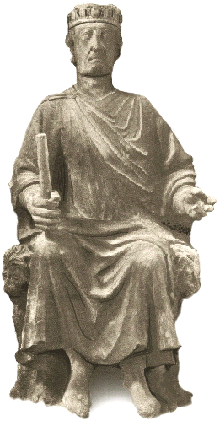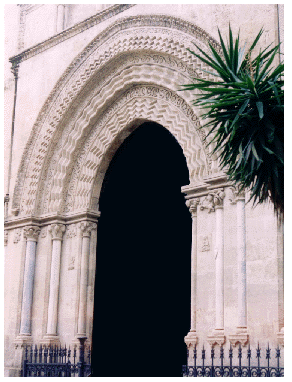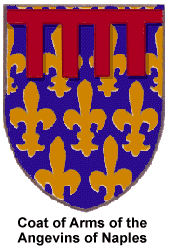...Best of Sicily presents... Best of Sicily Magazine. ... Dedicated to Sicilian art, culture, history, people, places and all things Sicilian. |
by L. Mendola and V. Salerno | |||||
Magazine Index Best of Sicily Arts & Culture Fashion Food & Wine History & Society About Us Travel Faqs Contact Map of Sicily
|
The Angevin era defined the decline of Sicily, and particularly Palermo, as a center of political and economic power. While acknowledging that Sicily was a kingdom in its own right, Charles ruled from Naples, which previously had been a prosperous but politically less important city than Palermo, Bari or Salerno. In Sicily, the changes were immediate. Thousands of French troops arrived, and taxes were increased. For the first time in centuries, Sicily was the "dominion" of a "foreign" ruler who saw no reason to visit the island. Worse, the Sicilians themselves were made to feel like subjects. In the years following 1268, Sicily was almost entirely Latinized. Except for a few monasteries in the Nebrodi region, the Christians were Catholic, and with Charles' help a later pope, Gregory X, attempted to subjugate the Eastern (Orthodox) Church of Constantinople. The new regime openly resented the Arabs of Lucera (in Puglia) and Sicily. Mosques were gradually abandoned; many were converted to churches. Jews were tolerated, though their communities became fewer outside the major cities. The Sicilian language had emerged as a Latin tongue, albeit with many Greek and Arabic words. In name, the Sicilian nobility had Norman, Swabian and Lombard roots. Truth be told, most Sicilian nobles had Arab or Byzantine ancestors, too. From the beginning, the nobility viewed the Angevin French in a negative light, initially as something of a nuisance and then as a repressive instrument of royal power. Charles of Anjou was anything but an enlightened ruler. His son, Charles "the Lame" of Salerno, was viewed by all, including his father, as weak and incompetent. Around Sicily a number of structures remain from the rather brief Angevin
period. Palermo's Church of Saint Francis of Assisi The expansionist policies of Charles were not limited to Italy. Apart from influence in northern Italy, he claimed the crown of Jerusalem borne by Frederick II. After Louis IX died on crusade in Tunisia in 1270, his son, Philip (who ruled France as Philip III), fell under the influence of Charles. By 1282, Charles ruled Sicily and southern Italy, Jerusalem, Albania, Provence, Anjou, Maine and part of Tunisia. He was preparing an invasion of Constantinople which would have finally brought the Byzantine world --and particularly its Church-- under Latin control. The new pope, Martin IV, a Frenchman, openly encouraged this. Charles was, without doubt, the most powerful European monarch. Two decades earlier, Manfred Hohenstaufen, an illegitimate son of Frederick II (but presumed heir to the thrones of Sicily and Germany) killed by Charles' Angevin forces at the Battle of Benevento in 1266, had betrothed his daughter, Constance, to Peter of Aragon. On this tenuous basis, a number of Sicilian nobles exiled from Charles' Kingdom since the 1260s sought the alliance of Peter I of Aragon, whose realm based at Barcelona included Catalonia and other prosperous regions of northeastern Spain. Based on the Sicilians' requests, but also on various other political issues, Peter soon began preparations for a war against Charles. Clearly, the rivalry between Guelphs (supporters of the Papacy and now the Angevins) and Ghibellines (supporters of the Holy Roman Emperor and Swabians) had not abated, but what followed was completely unexpected. On Easter Monday, 30 March, 1282, a popular revolt broke out, leading to the deaths of thousands of French, including numerous civilians. The uprising, later called the "Sicilian Vespers," spread across the island in a matter of days. The "War of the Vespers" was the first feudal revolt of this kind. Its efficiency and ruthlessness frightened monarchs far beyond Naples and Rome. Almost simultaneously, the French castellans and garrisons of Sicily's fortified cities were isolated and killed, in Palermo, Caccamo, Vicari, Caltanissetta, Girgenti (Agrigento), Caltanissetta, Milazzo, Castrogiovanni (Enna), Taormina, Catania... In September, Peter was formally nominated King of Sicily by the island's nobles. That, however, was not the end of the war. In a series of battles at sea and skirmishes on land, the Angevin forces were defeated by Aragonese-Sicilian ones. In one of the war's comical episodes, Charles and the younger Peter were to meet for a duel to decide the fate of Sicily, each accompanied by a hundred fighting knights. This was to take place in June 1283 at Bordeaux, capital of the neutral French territories of Edward, King of England. Each king agreed to appear with his suite but it was tacitly understood that each would arrive at a different time. Then each sovereign claimed that the other was a coward. In another incident, King Charles' incompetent son, Charles of Salerno, was taken prisoner at a sea battle in June 1284 and held in the citadel of Cefalù. When Charles died in January of 1285, Angevin power in Sicily had essentially
vanished. The new king of Naples, Following imprisonment in Catalonia, Charles the Lame eventually returned to Naples to reign as Charles II. James, the second son of Peter of Aragon, became King of Sicily. He was nineteen years old, crowned at Palermo in February 1286. He eventually left Sicily to ascend the Aragonese throne. A series of intrigues continued until 1302, with an Angevin-Aragonese treaty known as the Peace of Caltabellotta, following which King Frederick (younger brother of James) wed Eleanora, youngest daughter of Charles II. James had wed Blanche, another daughter of Charles II, in an effort to resolve through marriage what could not be settled with armed conflict. Iolanda, their sister, married Charles' son, Robert. The Angevin presence in Sicily was short-lived. Understandably - in light of the Vespers - their descendants in Sicily were few. To historians, the Angevin legacy in Sicily is essentially a dynastic question. For the remainder of the Middle Ages into the modern era, the island might occasionally be ruled from Palermo but its rulers were Aragonese (and Spanish). About the Authors: Luigi Mendola is the History Editor of Best of Sicily and author of several books. Palermo native Vincenzo Salerno, who contributed to this article, has written biographies of several famous Sicilians, including Frederick II and Giuseppe di Lampedusa. | ||||
Top of Page |
 Anjou is a region of west-central France traditionally
held as a fief of the French ruling family. The term "Angevin"
refers to both the "Plantagenet" dynasty of England from 1154
to 1399 (descendants of Geoffrey, Count of Anjou, and Matilda, daughter
of Henry I) and the dynasty that ruled southern Italy from Naples beginning
in the thirteenth century. In the time of
Anjou is a region of west-central France traditionally
held as a fief of the French ruling family. The term "Angevin"
refers to both the "Plantagenet" dynasty of England from 1154
to 1399 (descendants of Geoffrey, Count of Anjou, and Matilda, daughter
of Henry I) and the dynasty that ruled southern Italy from Naples beginning
in the thirteenth century. In the time of  (the portal is shown here), begun in 1255, exemplifies the "Italianate Gothic" style
--Italian but not particularly Gothic.
(the portal is shown here), begun in 1255, exemplifies the "Italianate Gothic" style
--Italian but not particularly Gothic. Charles "the Lame," was still
a prisoner, and Pope Martin at first refused to recognise
him as the late monarch's heir. In the event, Martin himself died a few
months after King Charles. In a gesture of alliance with his Angevin cousins,
Philip III of France, attacked Aragon, his army soon defeated as much by
malaria as by arms. Philip died in October 1285. Peter of Aragon died a
month later.
Charles "the Lame," was still
a prisoner, and Pope Martin at first refused to recognise
him as the late monarch's heir. In the event, Martin himself died a few
months after King Charles. In a gesture of alliance with his Angevin cousins,
Philip III of France, attacked Aragon, his army soon defeated as much by
malaria as by arms. Philip died in October 1285. Peter of Aragon died a
month later.